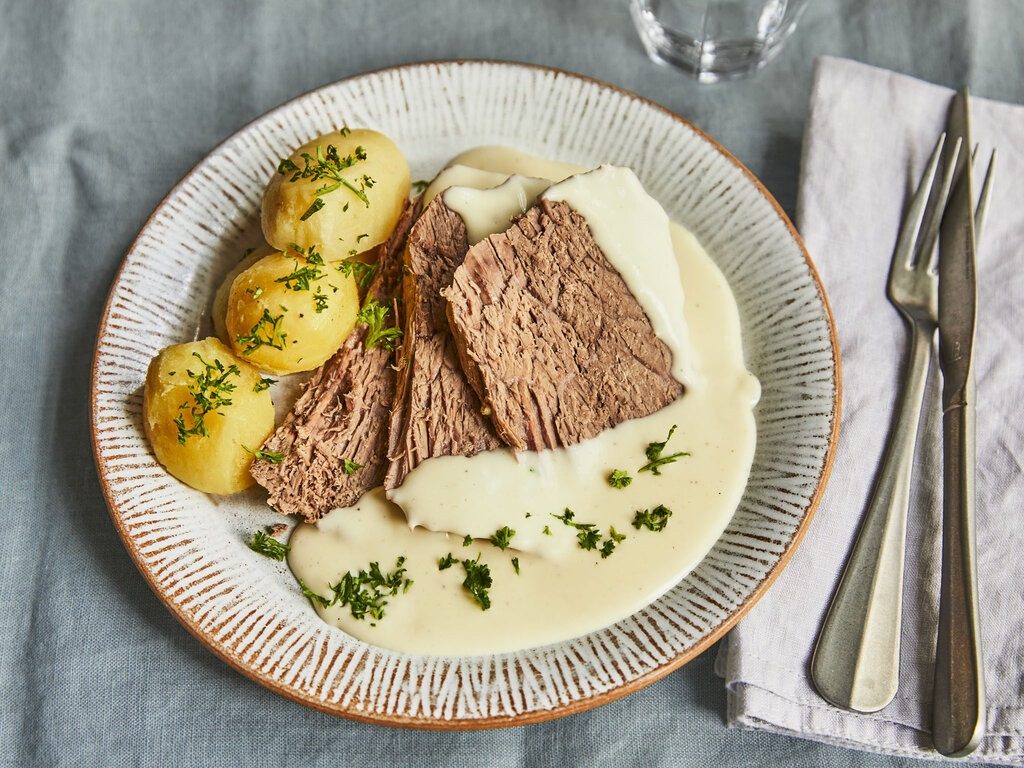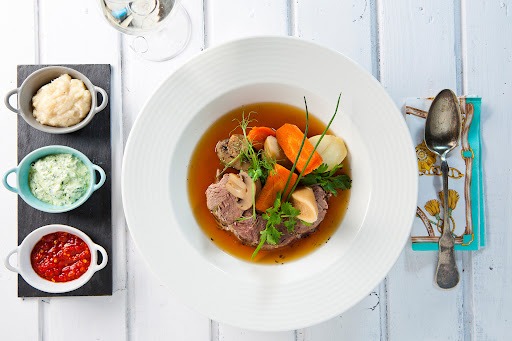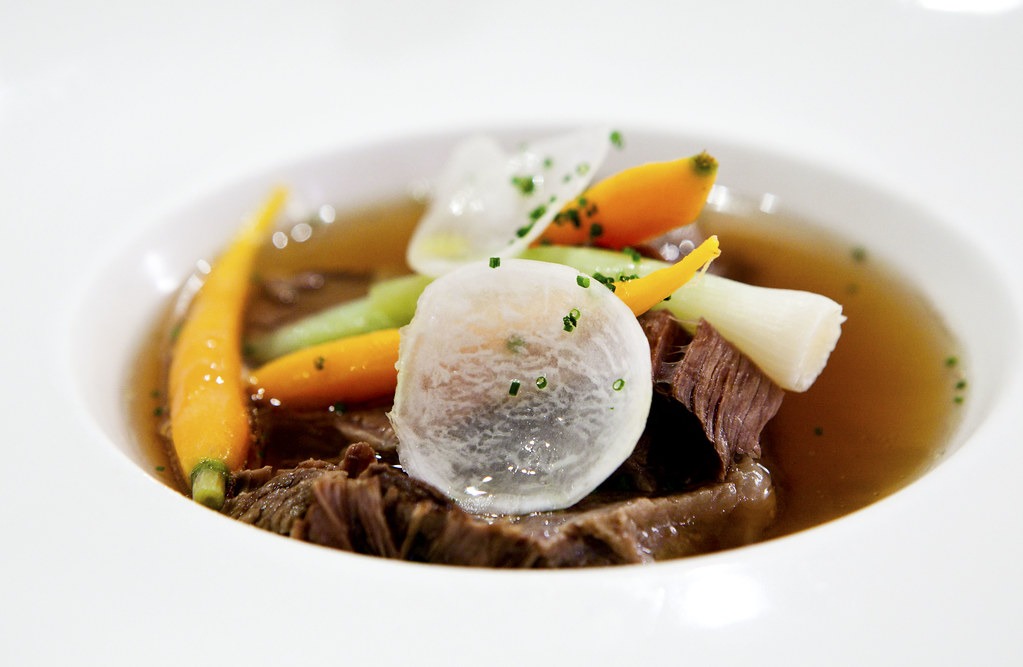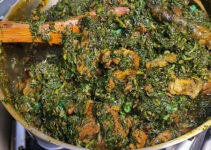Deep within the heart of Austrian cuisine lies a dish that epitomizes elegance, simplicity, and flavor – Tafelspitz. This iconic Austrian specialty has graced the tables of royalty and commoners alike, earning its place as a beloved culinary treasure cherished for its tender meat, fragrant broth, and timeless appeal.

The Origins:
Tafelspitz, which translates to “table point” or “table’s end,” traces its roots back to the imperial kitchens of Austria-Hungary during the 19th century. Legend has it that Emperor Franz Joseph I was particularly fond of this dish, elevating it to prominence and sparking a culinary craze across the empire.
The Recipe:
- At its core, Tafelspitz is a simple yet refined dish featuring boiled beef served with an array of traditional accompaniments. The key to its success lies in the quality of the ingredients and the meticulous preparation.
- To prepare Tafelspitz, a tender cut of beef, such as the tri-tip or rump, is simmered gently in a flavorful broth infused with aromatic vegetables and spices. Common additions include onions, carrots, celery, parsley, peppercorns, and bay leaves, which impart depth and complexity to the broth.
- Once the beef is cooked to perfection – tender but still retaining its texture – it is thinly sliced and arranged artfully on a platter. Traditionally, Tafelspitz is served with sides such as crisp, golden-brown potato rosti, creamy horseradish sauce, and tangy apple-horseradish relish, adding layers of flavor and texture to the dish.
The Experience:
Partaking in a Tafelspitz feast is not merely a culinary endeavor but a sensory journey steeped in tradition and hospitality. From the tantalizing aroma that wafts from the simmering pot to the tender, succulent meat that melts in the mouth, every aspect of the experience is designed to delight the senses and nourish the soul.
Variations and Innovations:

While Tafelspitz remains true to its classic recipe, chefs and home cooks alike have embraced innovation. Putting their own unique spin on this timeless dish.
In the rich tapestry of Austrian cuisine, Tafelspitz stands as a shining example of culinary excellence and cultural heritage. Its timeless appeal, simple yet refined preparation, and ability to bring people together in celebration make it a cherished symbol of Austrian gastronomy.
Analyzing the Merits and Shortcomings of Tafelspitz: A Culinary Evaluation
Tafelspitz, a cornerstone of Austrian cuisine, has garnered danatoto admiration for its refined simplicity and robust flavors. Yet, like any dish, it possesses both strengths and weaknesses that shape its culinary identity.
Advantages:
- Time-Honored Tradition: Tafelspitz embodies centuries of culinary tradition, originating from the imperial kitchens of Austria-Hungary. Its enduring popularity speaks to its ability to transcend time and trends, remaining a cherished symbol of Austrian gastronomy.
- Tender and Flavorful Meat: One of the primary merits of Tafelspitz lies in the quality and tenderness of the beef. When prepared correctly, the meat emerges from its slow simmer in the fragrant broth succulent and flavorful. Delighting the palate with each tender bite.
- Versatility in Accompaniments: While Tafelspitz is typically served with traditional sides such as potato rosti and horseradish sauce, its versatility allows for a variety of accompaniments. Chefs and home cooks can experiment with different sauces, vegetables, and starches to complement the rich flavors of the dish, catering to diverse tastes and preferences.
- Communal Dining Experience: Tafelspitz lends itself well to communal dining, fostering a sense of conviviality and camaraderie among diners. Sharing a platter of succulent beef, accompanied by an array of sides and condiments. Creates an atmosphere of warmth and hospitality, making it an ideal dish for gatherings and celebrations.

Disadvantages:
- Lengthy Preparation Time: The preparation of Tafelspitz is a time-intensive process, requiring patience and careful attention to detail. From simmering the beef in the broth to preparing the accompanying sides, the entire cooking process can span several hours. Making it less suitable for quick or spontaneous meals.
- Limited Culinary Creativity: While Tafelspitz is steeped in tradition, its adherence to a specific recipe and set of accompaniments may limit opportunities for culinary innovation. Chefs seeking to put their own twist on the dish may find themselves constrained by its historical roots and expectations of authenticity.
- Reliance on Quality Ingredients: The success of Tafelspitz hinges on the quality of its ingredients, particularly the beef and broth. Subpar cuts of meat or lackluster broth can detract from the overall flavor and enjoyment of the dish. Emphasizing the importance of sourcing high-quality ingredients for optimal results.
Conclusion:
Tafelspitz, with its rich history, tender meat, and communal appeal, holds a revered place in Austrian culinary tradition. While it boasts numerous strengths. Including its time-honored tradition and versatility in accompaniments. It also presents challenges such as lengthy preparation time and reliance on quality ingredients.
Read More Article About “Scrambled Eggs: Memahami Teknik Pembuatan yang Sempurna“



